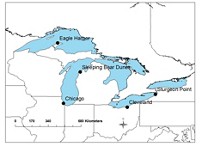Advertisement
Grab your lab coat. Let's get started
Welcome!
Welcome!
Create an account below to get 6 C&EN articles per month, receive newsletters and more - all free.
It seems this is your first time logging in online. Please enter the following information to continue.
As an ACS member you automatically get access to this site. All we need is few more details to create your reading experience.
Not you? Sign in with a different account.
Not you? Sign in with a different account.
ERROR 1
ERROR 1
ERROR 2
ERROR 2
ERROR 2
ERROR 2
ERROR 2
Password and Confirm password must match.
If you have an ACS member number, please enter it here so we can link this account to your membership. (optional)
ERROR 2
ACS values your privacy. By submitting your information, you are gaining access to C&EN and subscribing to our weekly newsletter. We use the information you provide to make your reading experience better, and we will never sell your data to third party members.
Environment
Levels Of Persistent Flame Retardants Decline In San Francisco Bay
Environment: Controversial PBDEs have started to disappear in bay sediment and wildlife after industry phaseouts and government bans
by Puneet Kollipara
January 13, 2015

In the San Francisco Bay, levels of one class of flame retardants have fallen over the past decade, according to a new study. The data on the highly controversial polybrominated diphenyl ethers (PBDEs) suggest that policies restricting use of a chemical, even a persistent one, can work quickly to reduce its burden on the environment, the researchers say (Environ Sci. Technol. 2014, DOI: 10.1021/es503727b).
“The study really shows that once regulations are put in place, things change fairly rapidly in the environment,” says Marta Venier, an environmental chemist at Indiana University, who wasn’t involved in the work. “I think we need more and more of these studies to convince regulators” of the value of moving forward with regulations for controversial substances, she adds.
Flame retardants are used widely in furniture, electronics, and other consumer products. Environmental scientists have argued for regulations on the chemicals because they can easily volatilize and escape into the environment. Also, studies have shown that PBDEs break down slowly and could harm neurological development and potentially disrupt hormone signaling in humans and animals. As a result, the U.S. banned the manufacture and import of one PBDE formulation, pentaBDE, in 2005, and another, decaBDE, is currently being phased out nationally. Industry has started to move away from PBDEs to other flame-retardant families.
Rebecca Sutton of San Francisco Estuary Institute (SFEI), a nonprofit environmental science group, and her colleagues wondered whether these regulatory actions were having any detectable impact on the San Francisco Bay. Being in an urban area, the bay makes a good natural laboratory because it receives a lot of industrial discharge and treated domestic wastewater, Sutton says.
The team reviewed data collected between 2002 and 2012 by a coalition consisting of SFEI, local governments, and wastewater-discharging companies. In particular, the researchers looked at levels of BDE-47, a major component of pentaBDE, and BDE-209, the main component of decaBDE, in sediments and water, as well as total concentrations of PBDE flame retardants in wildlife.
Levels of pentaBDE fell by one-third in sediments, but its levels in water showed no significant change. The decaBDE data showed no significant changes over the decade. Sutton says this isn’t surprising given that industry has only recently phased out the chemical. She thinks its levels will likely decline in the coming years as industry stops using it.
In wildlife, however, the results were starker. Concentrations of total PBDEs fell by almost 50% in sport fish, and between 74 and 93% in birds. The researchers believe that the concentration drops—in wildlife, sediments, and water—may be due, in part, to the chemicals dispersing farther into the environment, as well as to microbes breaking down the compounds.
Although these data suggest that levels of certain PBDEs may be dropping in the environment, environmental concerns about flame retardants, as a whole, haven’t abated. Companies often switch from a regulated or phased-out chemical to a closely related one that hasn’t yet seen public scrutiny, Indiana’s Venier says. Some research suggests that flame retardants, such as 2-ethylhexyl-2,3,4,5-tetrabromobenzoate (TBB) and bis(2-ethylhexyl)-tetrabromophthalate (TBPH), have started increasing in the environment as the compounds replace PBDEs in industry. “We are definitely playing this whack-a-mole game with these chemicals,” Venier says.





Join the conversation
Contact the reporter
Submit a Letter to the Editor for publication
Engage with us on Twitter